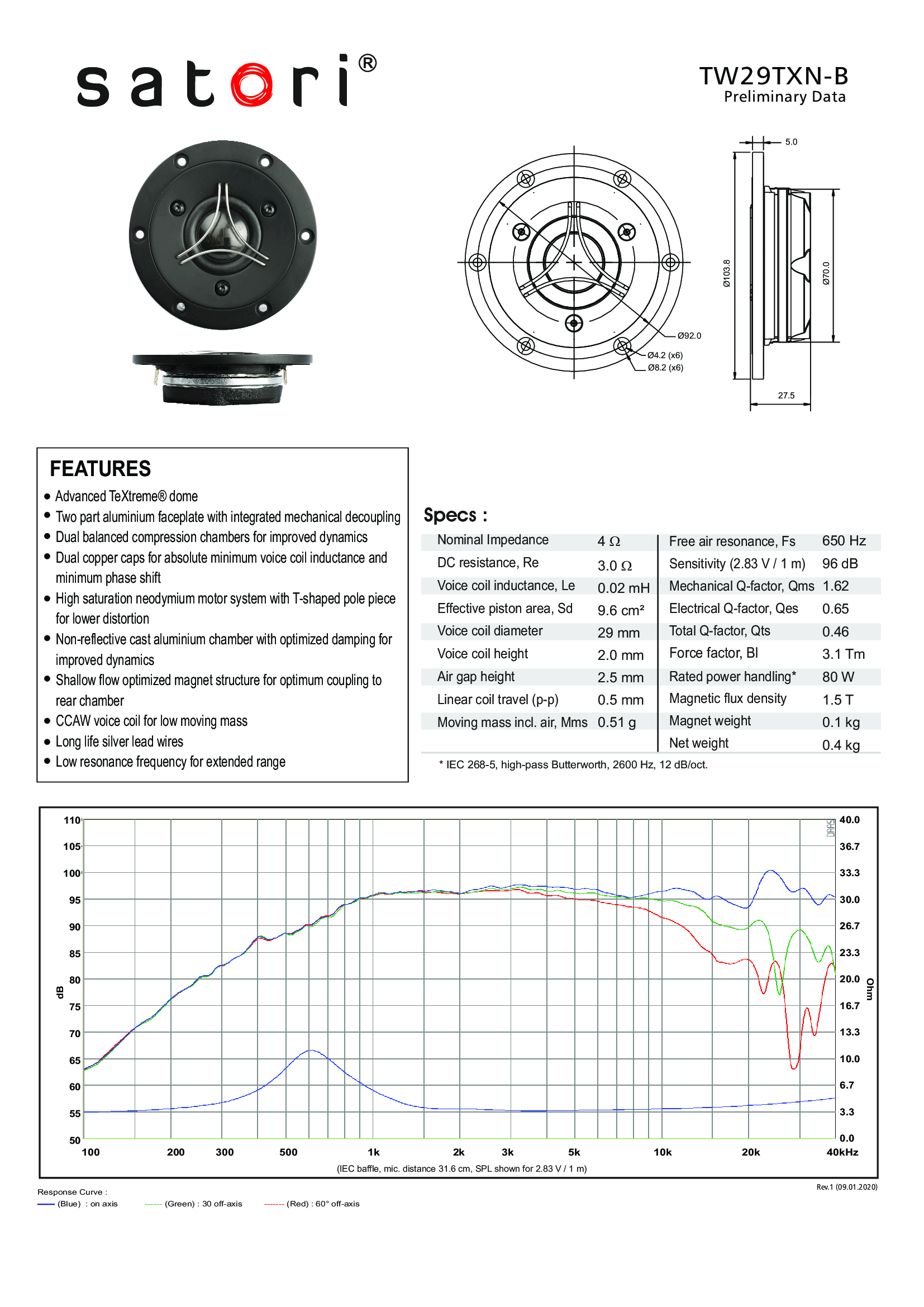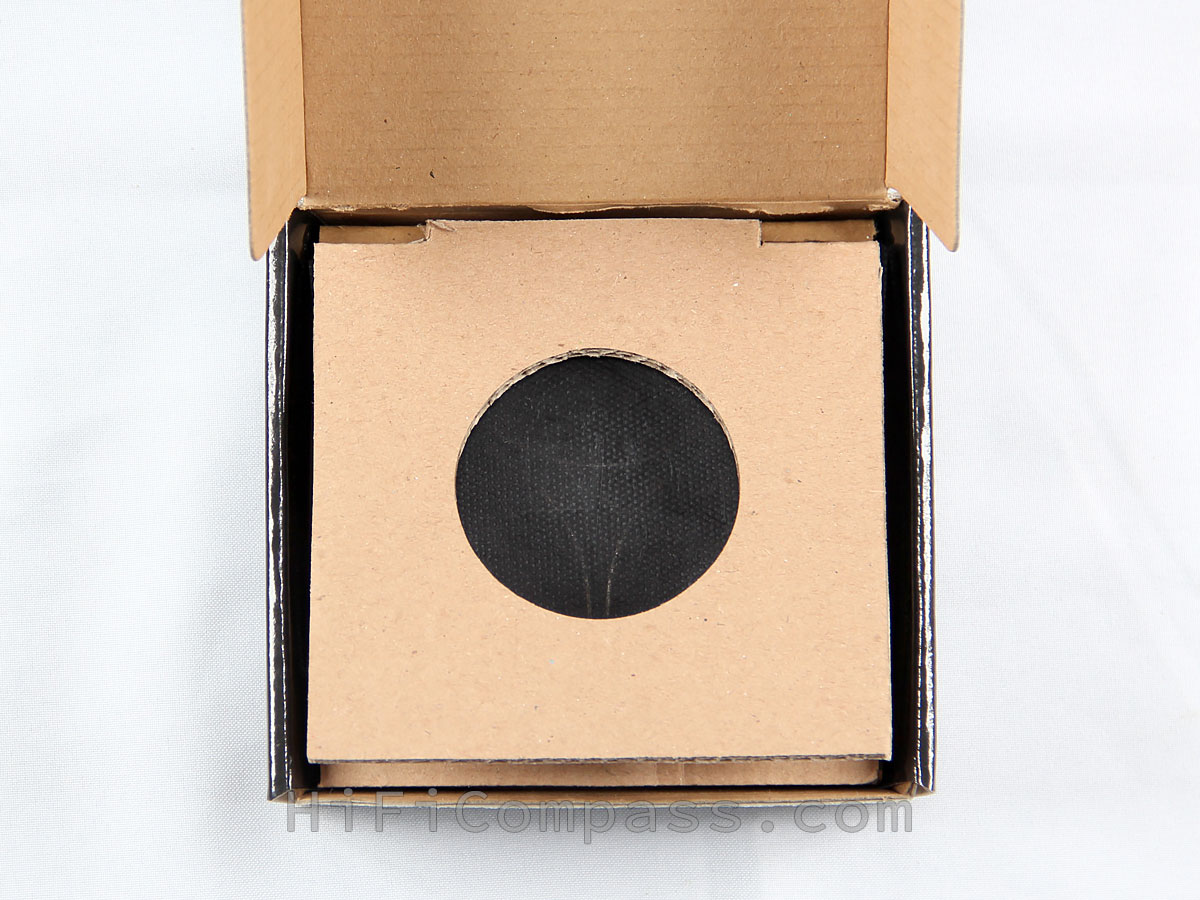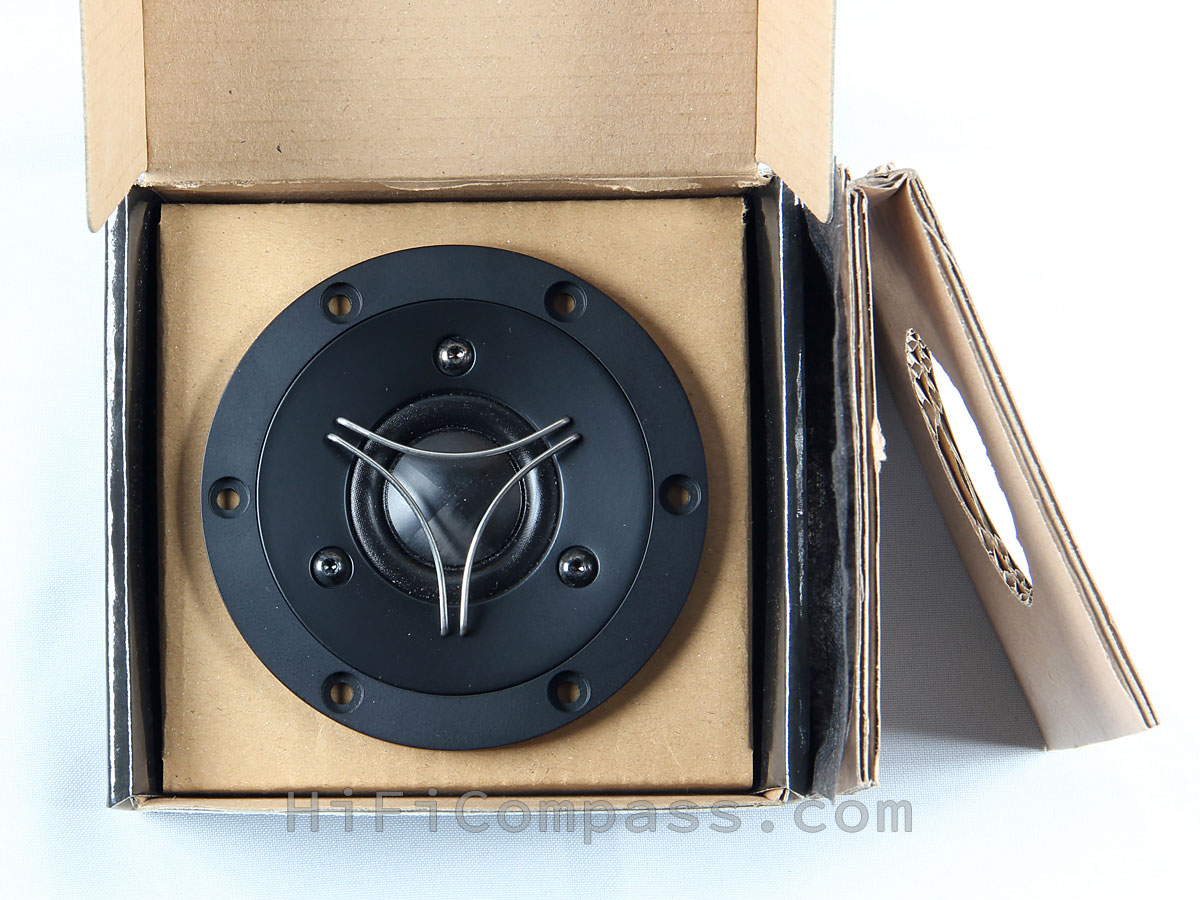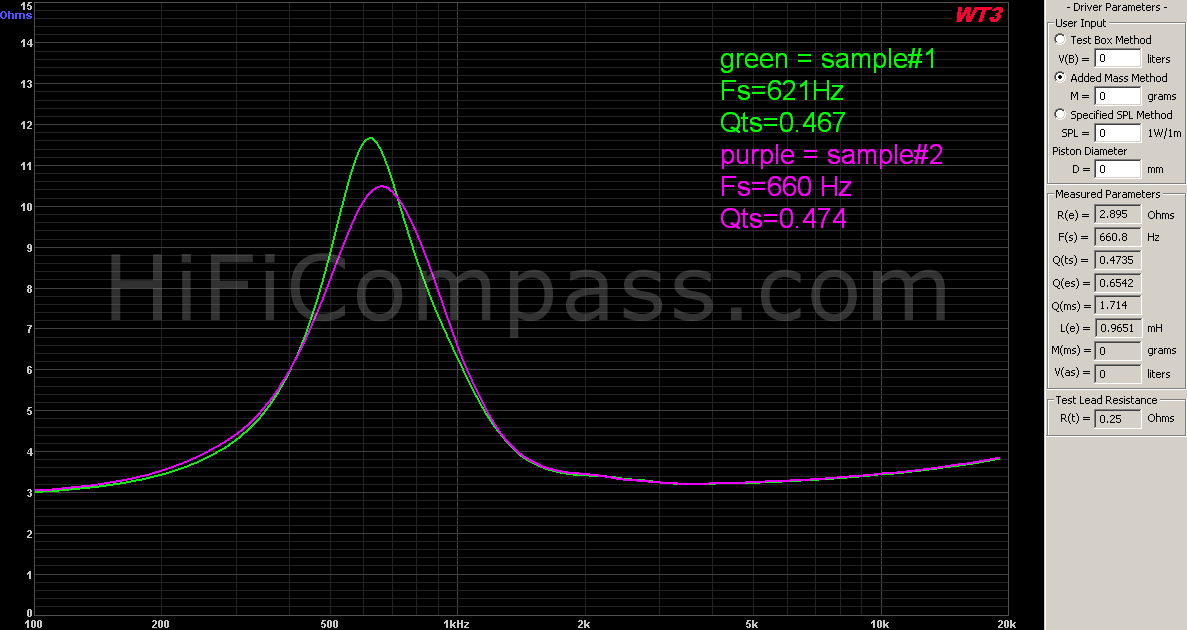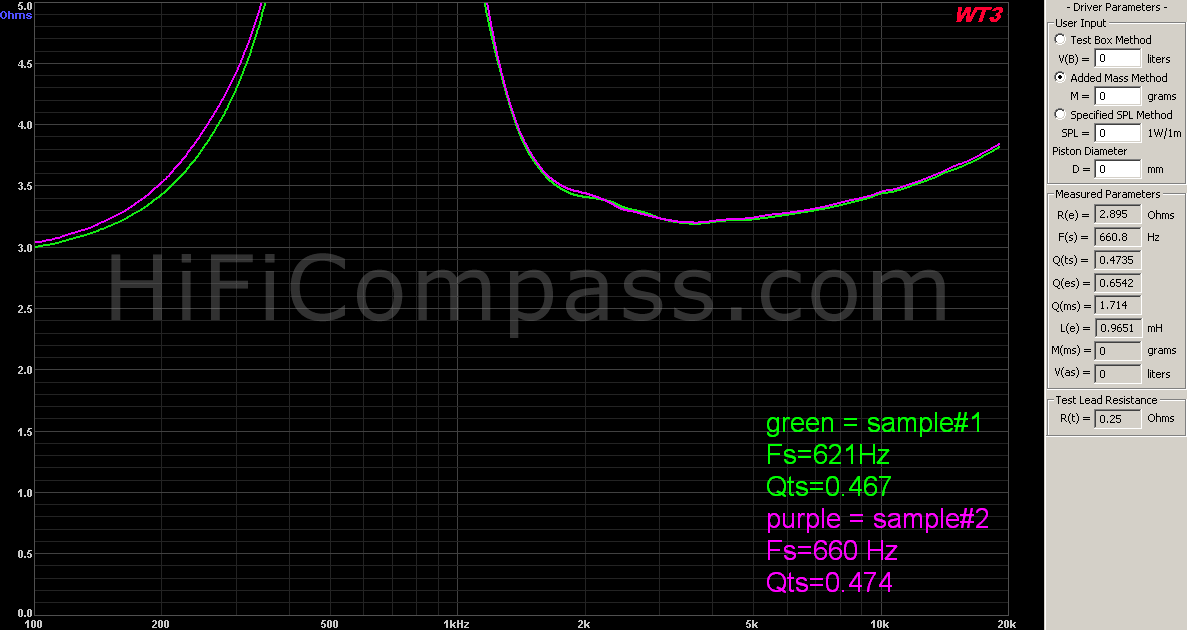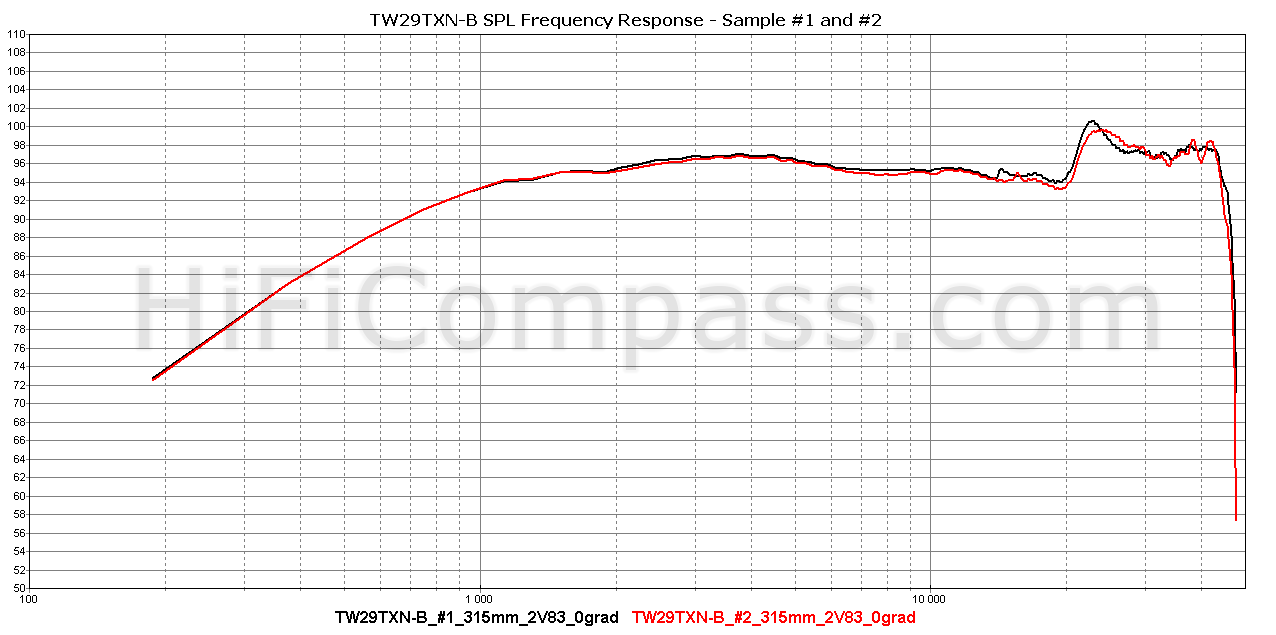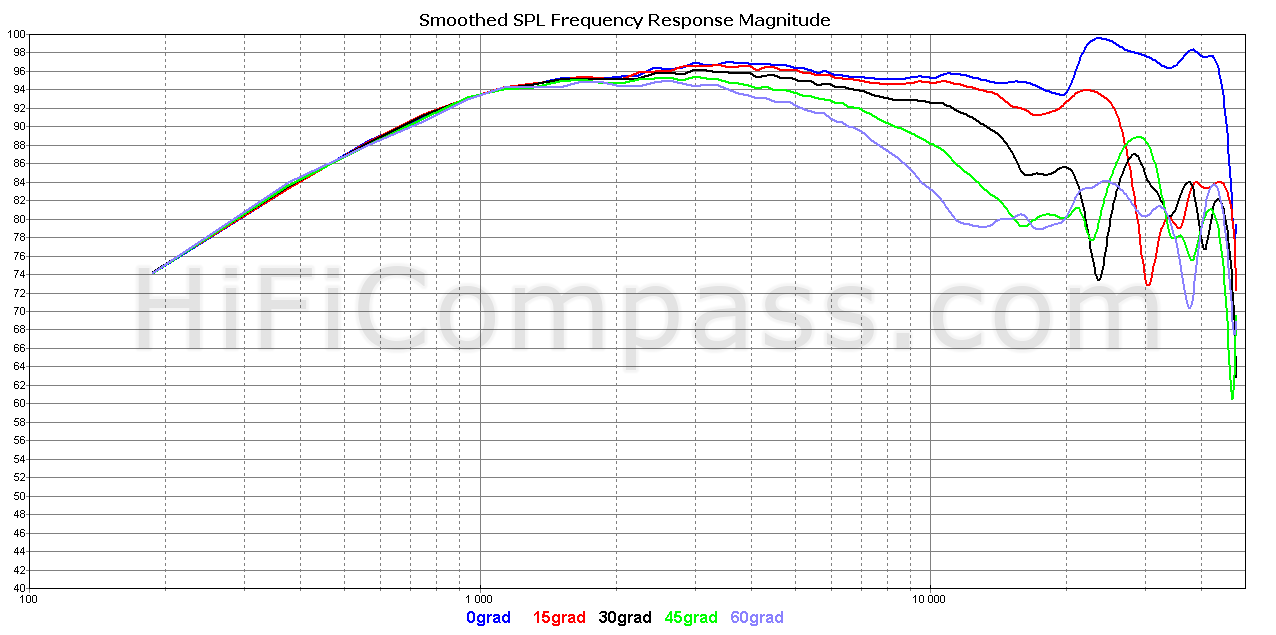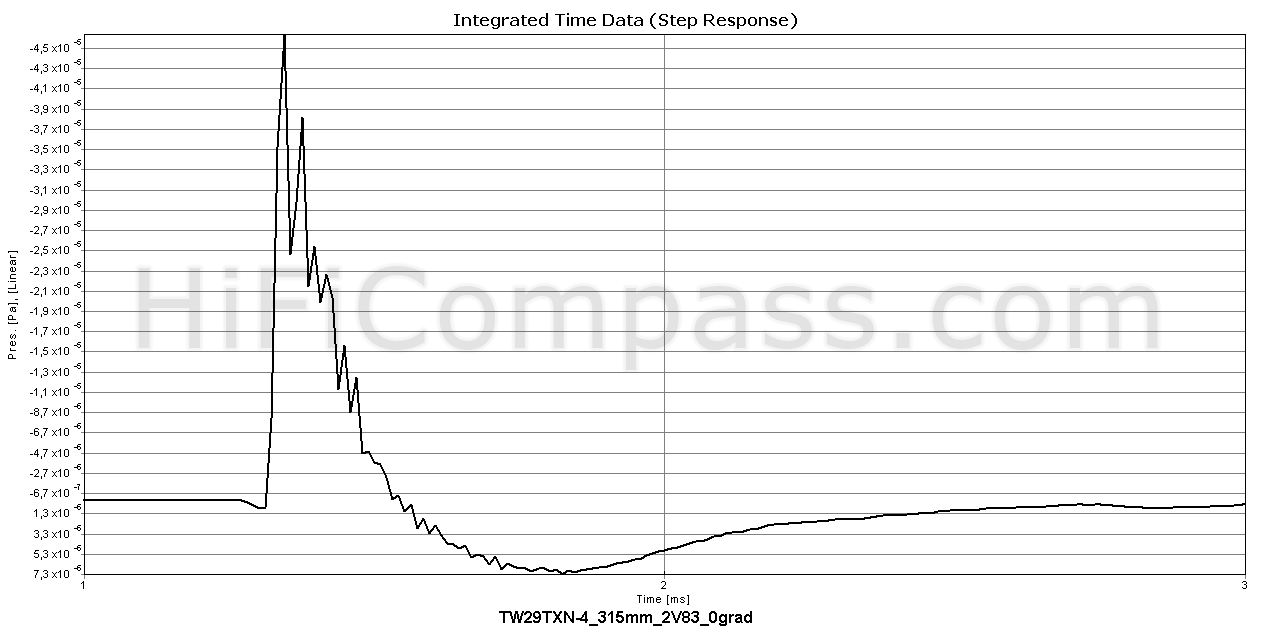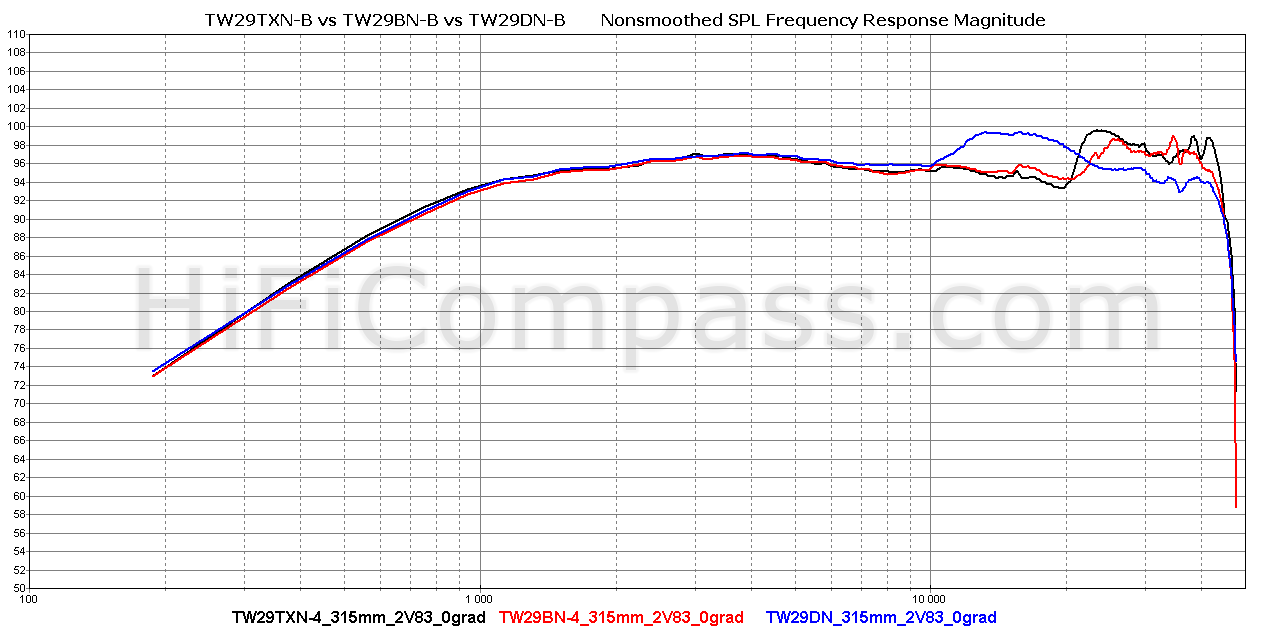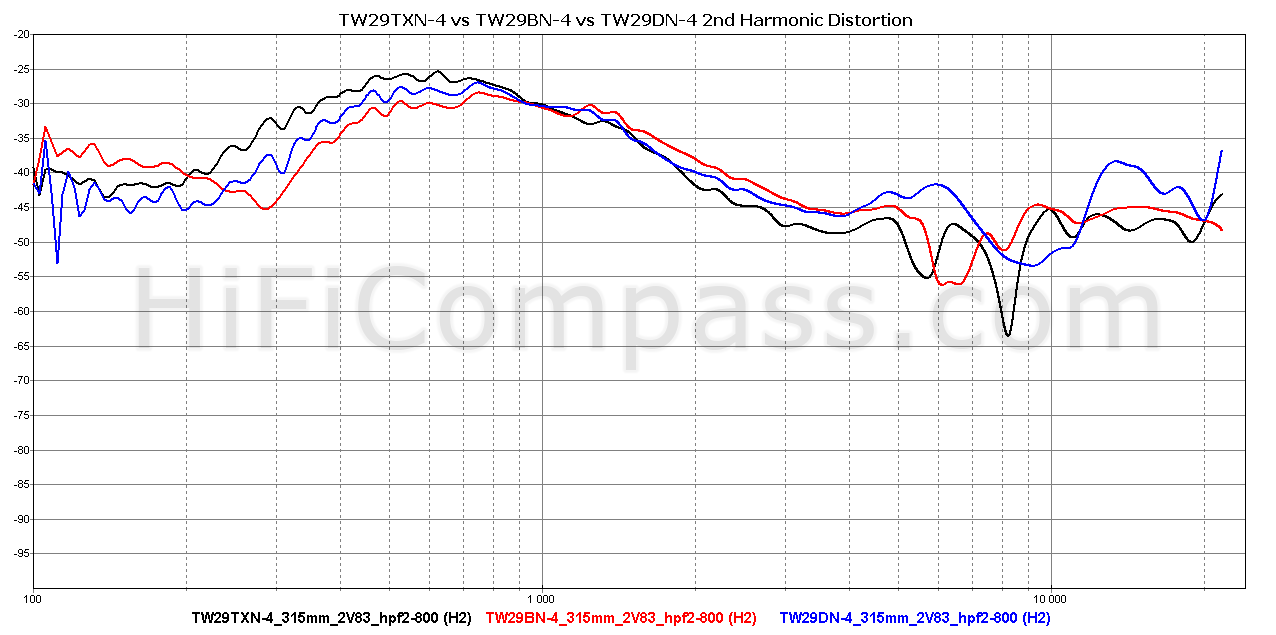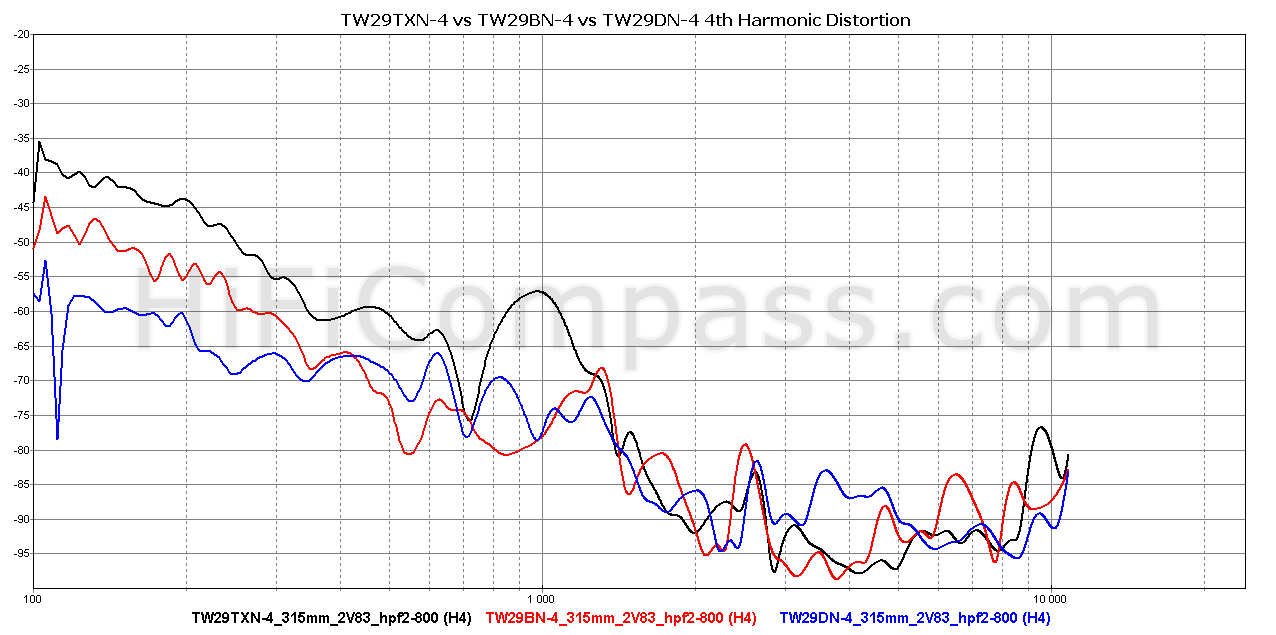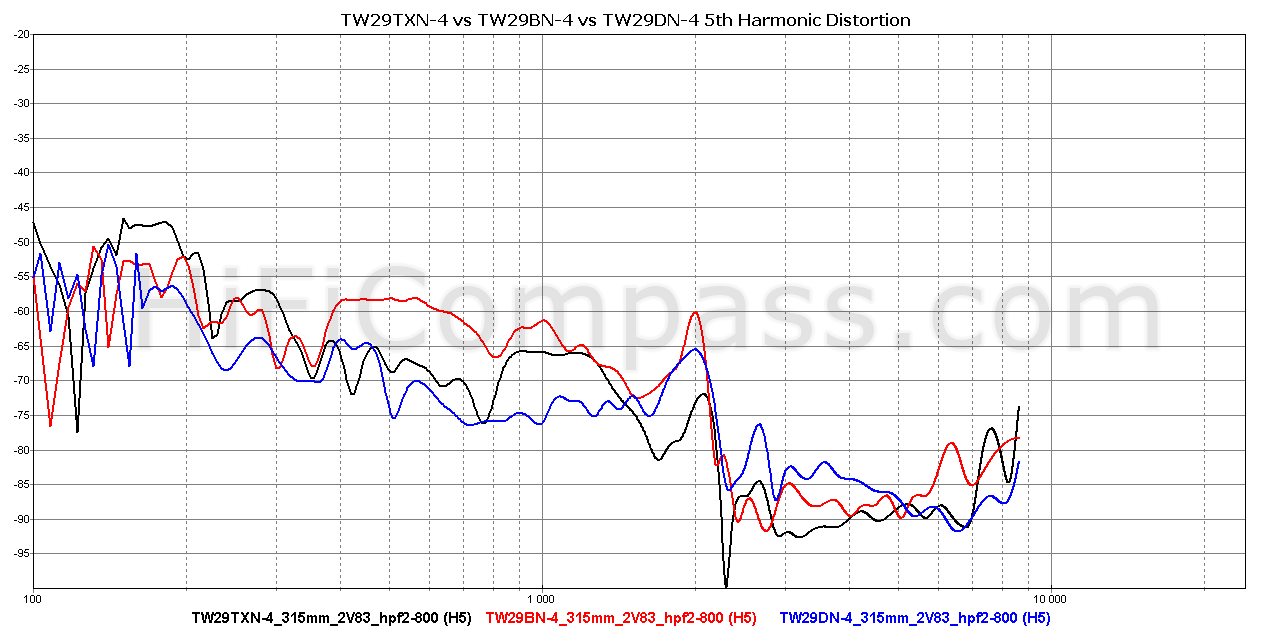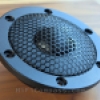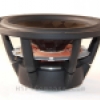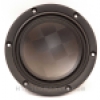HiFiCompass
Satori TW29TXN-B
What is on the test bench?
Today's Satori TW29TXN-B tweeter review completes the Satori TeXtreme line reviews. As the two previous reviews have shown, the new membrane material has proven itself in the Satori MW16TX-4 and Satori MW19TX-4 midwoofers in the best way. Now let's see how it works at high frequencies.
TeXtreme is a new word that came into the "high-end world" in the spring of 2019 and has been exciting audiophiles minds ever since. It all started with the presentation by the Swedish company Oxeon of the newest type of membrane for speakers - TPCD (Thin Ply Carbon Diaphragm) based on TeXtreme, as evidenced by the publication in the AudioXpress magazine. This was followed by the presentation at the Munich HighEnd-2019 by the Satori brand of new speakers using TeXtreme membranes - the Satori TW29TXN tweeter and Satori MW16TX midwoofer, and a demonstration of based on them loudspeakers developed by Danesian Audio.
Oxeon was founded in 2003 and introduced the TeXtreme to the world in 2004. So the material is by no means that new. Since then, it has been widely used as a heavy-duty and lightweight composite material in aviation, sports and industry. It is used to manufacture body parts for racing cars, aircraft seats, protective helmets for athletes, bicycle frames, golf clubs, skis and many more. However, it came in audio only in 2019 with the invention of TPCD membranes.
TeXtreme is a trademark of the company that means three concepts at the same time:
- the technology of converting a conventional multifilament (carbon, aramid, etc.), which is a thread of thousands of microfibers with a diameter of several microns, into a flat tape, where these fibers are strictly oriented parallel to each other (spread tow)
- the technology of weaving fabrics from wide flat tapes (thin ply)
- the fabric itself from these flat tapes
So, the term TeXtreme can mean both the technology of fabrication itself and the fabric itself. In the context of interest to all of us we will mean just the fabric and just from the spreaded carbon fiber.
The main advantages of TeXtreme over conventional carbon fabric are the strictly parallel arrangement of the fibers and the absence of their mutual twisting when they are distributed into flat tapes. This reduces the amount of voids in the yarn. Further, the wide flat tape weaving technology provides a much denser filling of a fabric surface with fibers, significantly reducing the amount of voids that must then be sealed with epoxy. Everything contributes to a higher specific content of carbon fibers in the fabric, greater strength and less weight.
Carbon fibers have been used in the manufacture of speaker membranes for many years and have already managed to take their place in the top models of speaker drivers and loudspeakers leading world companies - Rockport Technologies (USA), Magico (USA), Kharma (Netherlands), Morel (Israel). SB Acoustics also has in its portfolio several carbon fibers membrane models - SB17CRC35-4(8) and SB15CRC30-4(8). A distinctive feature of all the speakers of the aforementioned companies is their membranes are made using the "Rohacell foam/Carbon" sandwich technology, when between layers of thin carbon fabric there is a thick layer of light and strong Rohacell polyacrylate foam. Howether the mass of such membranes limits their use only to bass and midrange speakers.
The new TPCD membranes are a two-layer TeXtreme laminate structure, which already allows them to be used as membranes for tweeters. As a result, the new technology makes it possible to build a multi-way loudspeakers on speaker drivers with the same type of membrane. This should have a beneficial effect on the homogeneity of the overall sound.
For those who want to learn more about the TeXtreme technology features, I recommend reading the Oxeon presentation.
Here you can learn about the history of the SB Acoustics and Satori brands, as well as one of the world's largest speaker drivers manufacturer - Sinar Baja Electric (www.sinarbajaelectric.com).
Why do we test this?
Sinar Baja Electric has kindly provided seven of its latest models for independent testing:
Tweeter SB Acoustics SB21SDCN-C000-4
Tweeter SB Acoustics SB21RDCN-C000-4
Tweeter Satori TW29TXN-B
Tweeter Satori TW29BNWG-4
Midrange Satori MD60N-6
Midwoofer Satori MW16TX-4
Midwoofer Satori MW19TX-4
Since all the models are just beginning to enter the market, it is impossible to find any additional information, except for meager numbers from the datasheets. Today's review opens a series of tests, the purpose of which will try to make up for the lack of information and to acquaint everyone with detailed technical characteristics and application features of the new speaker models
I would like to express my deep gratitude to Sinar Baja Electric company for the provided new products, as well as personally Mark Thomsen (International Sales & Marketing Manager SB Audience | SB Acoustics) and Melly Wulandari (SB Acoustics Project Manager) for their assistance in implementing the series of reviews.
What did the manufacturer state?
Of all the parameters I would highlight the high sensitivity - 96 dB/2.83 Volt*1m (despite the relatively high moving mass - 0.51 g) and the low resonance frequency - 600 Hz.
Visual inspection
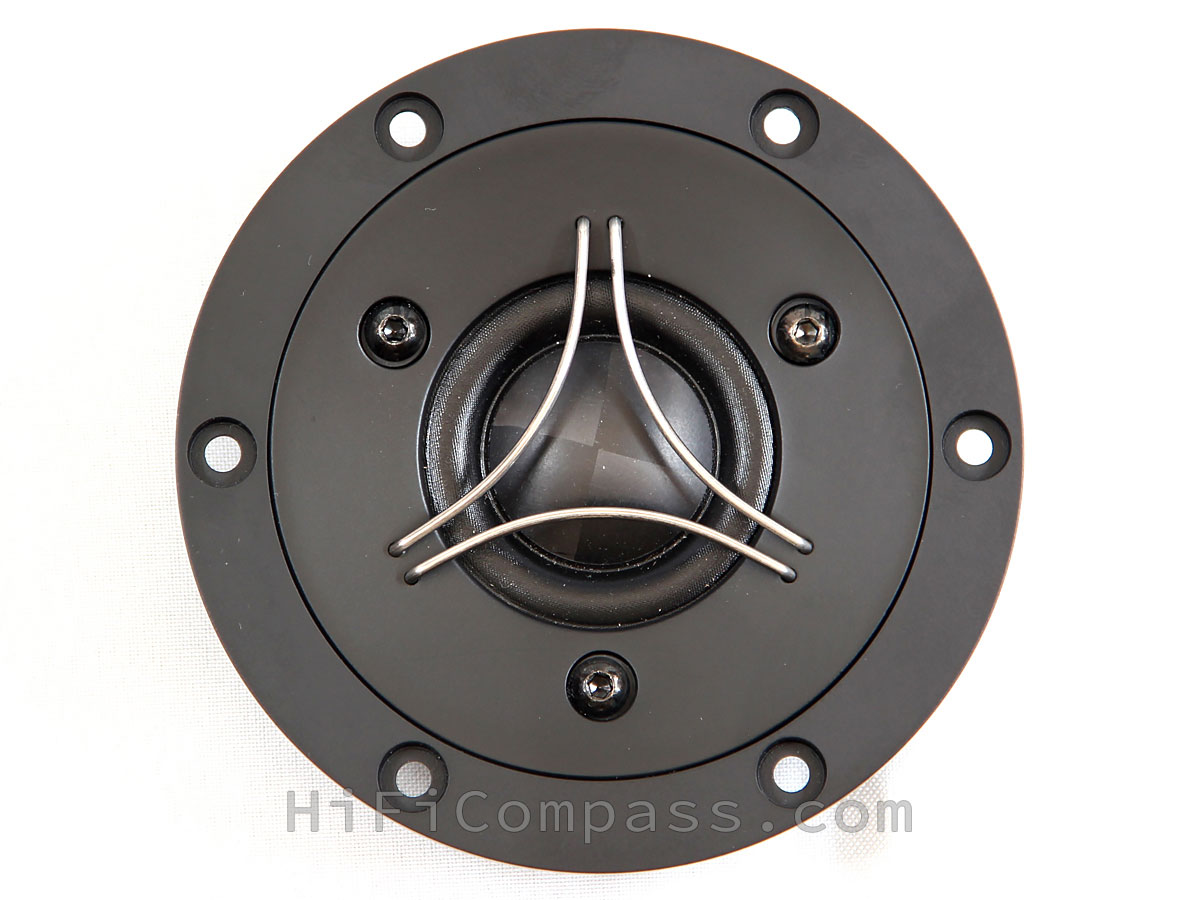 |
 |
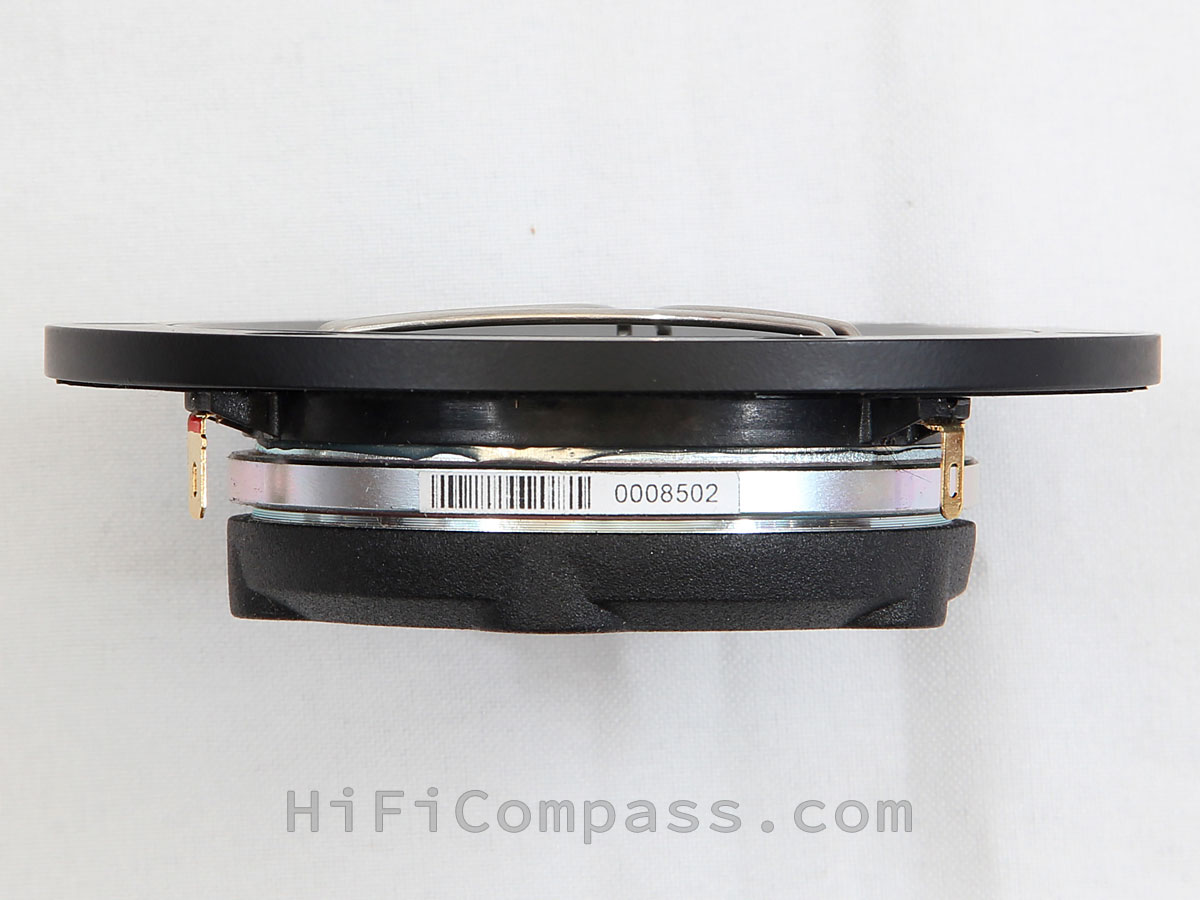 |
The TW29TXN-B comes in a sturdy glossy corrugated cardboard packaging. Inside the box the speaker "sits" in the hole of the U-shaped cardboard frame and is pressed from the front side with a double cardboard spacer. To protect the tweeter from a dust, accidental scratches and abrasions, it is covered with a soft, slotted cloth. Everything is simple and very reliable. The packaging is exemplary.
The production quality is exemplary, there is nothing to complain about. Perfectly fitted parts, complete absence of any cosmetic defects, no burrs, distortions, chips and traces of glue. The label is perfectly aligned.
The faceplate is made of 6 mm aluminium with a smooth matt powder coating and consists of two parts, which are joined together by a thin layer of elastic vibration damping material. This unique design is used only in the Satori tweeters to my knowledge. Its purpose is to prevent transmission of loudspeaker cabinet vibrations to the tweeter motor and, so that, to eliminate parasitic modulation of its moving system. However, the connection between the faceplate parts is such rigid, that I can hardly believe the effectiveness of this design.
The faceplate is quite thick and inert when tapped with a finger. On the front side it is not flat, but slightly concave to help in shaping of desired frequency response. In front of it three steel brackets are pressed into it, protecting the membrane from dangerous accidental touches. I really like this solution. Despite the fact that it does not protect the membrane from hitting of small magnetic particles, it still protects the membrane from large objects and accidental finger touches. And most importantly, such protection is much more transparent for radiated sound and less spoiling to the frequency response than classic grids. A foam rubber seal is built into the back of the faceplate.
The back chamber of an complex shape is made of aluminum and covered with a black micro-textured powder coating. In the central part there is a very deep cone-shaped funnel that forms a corresponding cone in the inner cavity, penetrating through the vent hole in the pole piece of the motor. On the back chamber there are five concentrically located dimples, which, in my opinion, also form the profile of the internal cavity. All these measures are aimed at optimizing the internal air flow inside the motor and reducing the reflections of sound energy emitted from the back of the membrane.
When tapped with a finger, the center part of the back chamber slightly responds with a ringing in the 5 kHz region. I don’t know if this could have any effect on the tweeter's work. We'll see.
The side surface of a massive ring neodymium magnet is visible between the back chamber and the plastic frame of the moving system.
The gold-plated terminals are pressed into “ears” of plastic frame. There is a lot of space around them, so connecting to them is very convenient and easy. However, the terminals and plastic "ears" are flimsy and there is a risk of damage with careless handling.
The very low-profile TeXtreme membrane, in contrast to the regular carbon fiber membranes, is perfectly smooth with a pleasant matt silky sheen. Thanks to the microfiber structure it shimmers very beautifully at different angles of incidence of light. The membrane large size catches the eye immediately. Its diameter is 29 mm, which is very noticeable compared with common 26 mm membranes. The sense of size is further enhanced by the very wide, low-profile fabric surround. This dampened fabric looks and feels similar to that found on all the Satori and SB Acoustics tweeters. It is not sticky, but loves to collect dust.
Well thought out design and excellent workmanship!
Impedance frequency response
Thanks to a motor with a copper sleeve the impedance curve exhibits extremely low inductance and rises with frequency. The curve is very smooth. A slight "swelling" in the 2.3 kHz region is an echo of the interaction of the moving system with the back chamber. There is nothing to care about, in my opinion. Only at a very large scale, if you strain too much, you can hardly discern slight disturbance in the curve at 10 kHz and 14 kHz.
The impedance response tells us about an excellent motor and well damped moving system and the tweeter internal cavity. The parameters consistency is good.
On-axis frequency response
The mesured sensitivity in the range from 1.1 to 21 kHz averaged 95 dB, which is 1 dB lower the datasheet value. The response has a flat character with no tilt and extends as minimum to the high frequency limit of my measurement system - 42 kHz. The total unevenness in the 1.1 kHz - 21 kHz range doesn't exceed 3 dB.
There is a slight swell of 2 dB in the 2 - 6 kHz range. In fact, this is the region where the tweeter efficiency is at its maximum and the following response decrease with frequency increasing is due to the increase in the voice coil impedance. You can also see that the 2 kHz swell in the impedance is reflected in the frequency response. This is a common effect for the back chambered tweeters.
Small peaks can be seen at 10 kHz and 14 kHz, right at the same plase as in the impedance response too. The frequency response does a stepwise transition from 94 to 98 dB at 20 kHz. This transition starts with a small resonant peak. I don't think this is the first sign of the membrane break-up. Comparing the TW29TXN with its beryllium sibling TW29BN suggests the fabric surround may be the cause.
The frequency response does not imply any difficulties when designing a loudspeaker crossover.
The responses of the two samples are almost identical to each other in shape, but differ in level from 0.2 to 0.4 dB in the 2 - 20 kHz range. It is quite acceptable for tweeters unsorted in matched pairs at a factory
The measured frequency response in the 8-15 kHz range slightly differs from the datasheet.
Off-axis frequency responses (at 315 mm)
The datasheet's off-axis responses doesn't correspond to reality. It seems that the manufacturer's 60-degree frequency response is more similar to that measured at 40 degrees, and the 30-degree response is more similar to that measured at 15 degrees.
Harmonic distortion (at 315 mm)
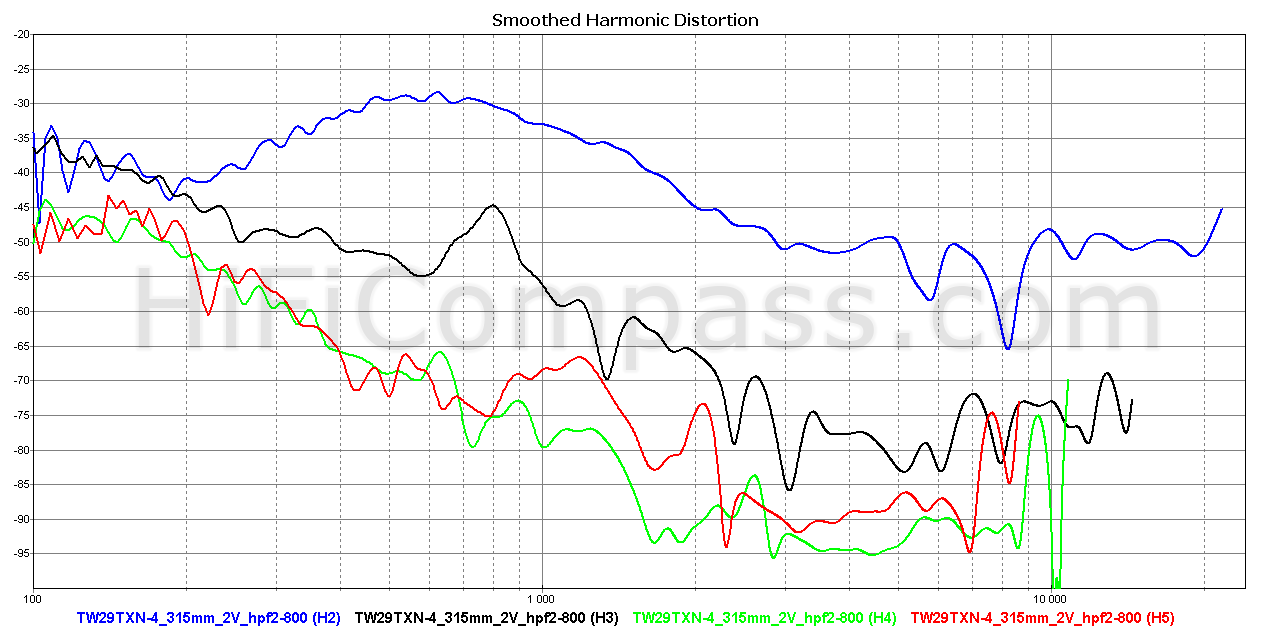 |
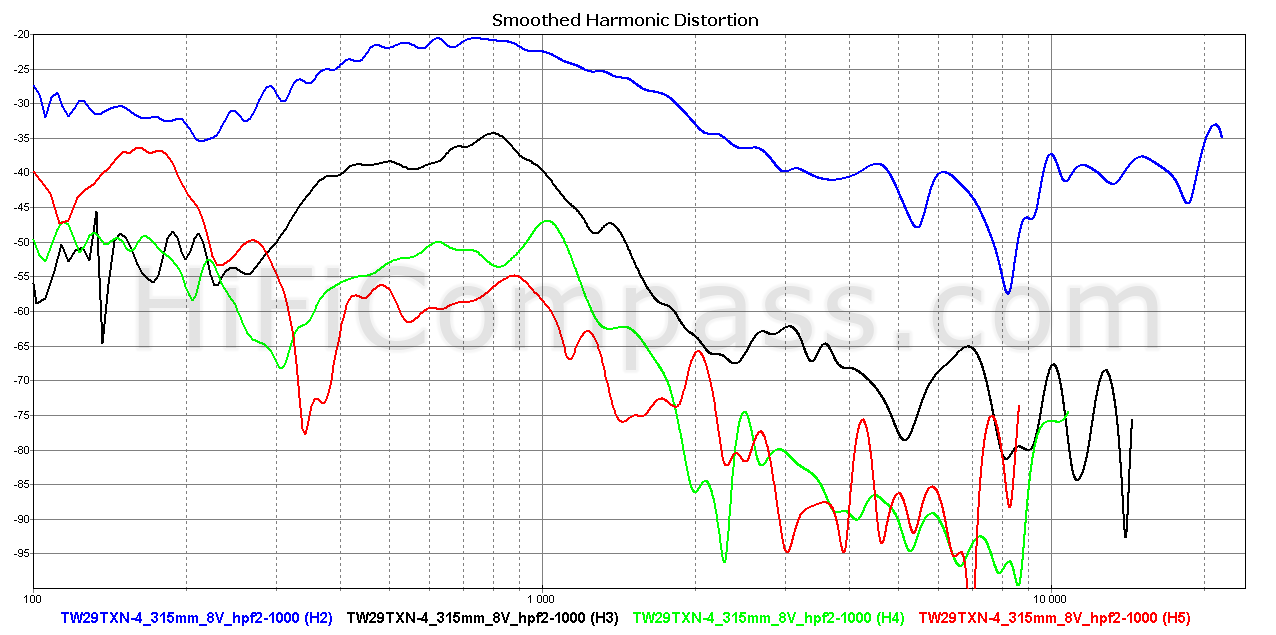 |
Above are the harmonic distortions plots for the 2nd - 5th harmonics at average sound pressure levels of 92 and 104 dB (at voltages of 2 and 8 Volts respectively). To limit the speaker overload in terms of thermal power and membrane displacement when measuring harmonic distortion, a second-order Butterworth type high-pass filter with a cutoff frequency of 800 Hz was used.
The second harmonic dominates the entire frequency range at all sound pressure levels. The third harmonic goes 20-30 dB lower, and the fourth and fifth even lower with a large margin. The harmonic distortion pattern is stable at both frequency and SPL. There are no sudden abrupt jumps in distortion over the entire range due to the membrane break-up, especially at high SPL. With an increase in the input voltage, starting from 2 kHz and below, harmonics of all orders begin to grow monotonically.
I would rate the harmonic distortion of the TW29TXN-B as "very low", one of the lowest I have ever seen in tweeters. Excellent!
Voice coil current harmonic distortion
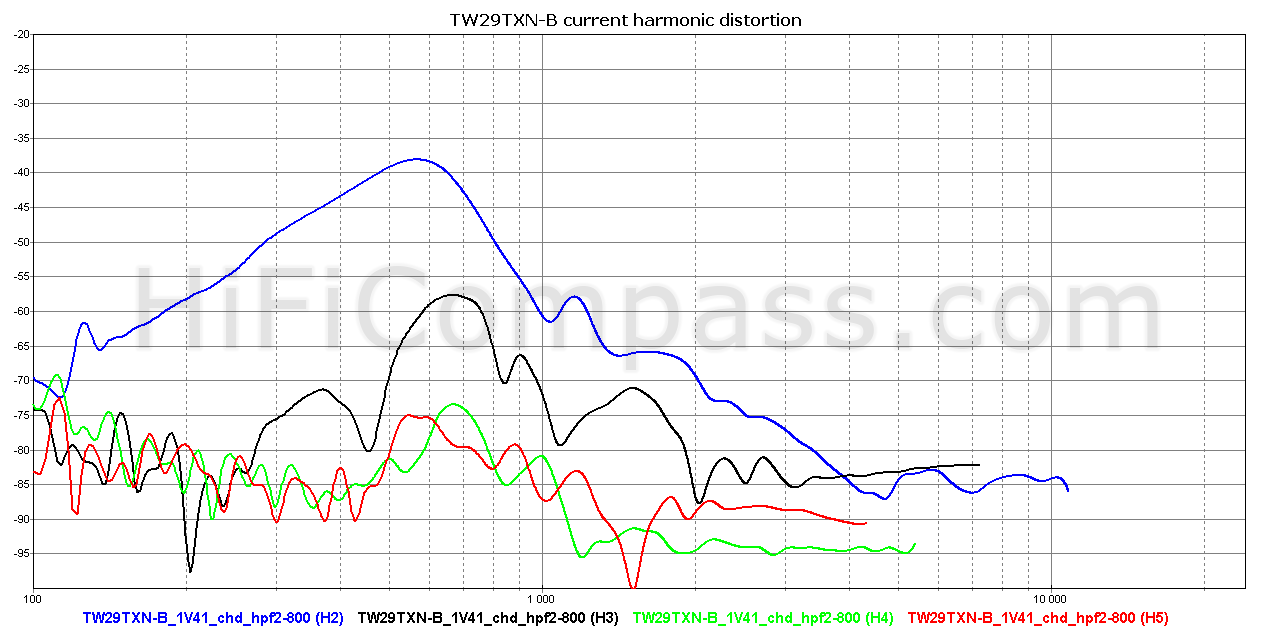 |
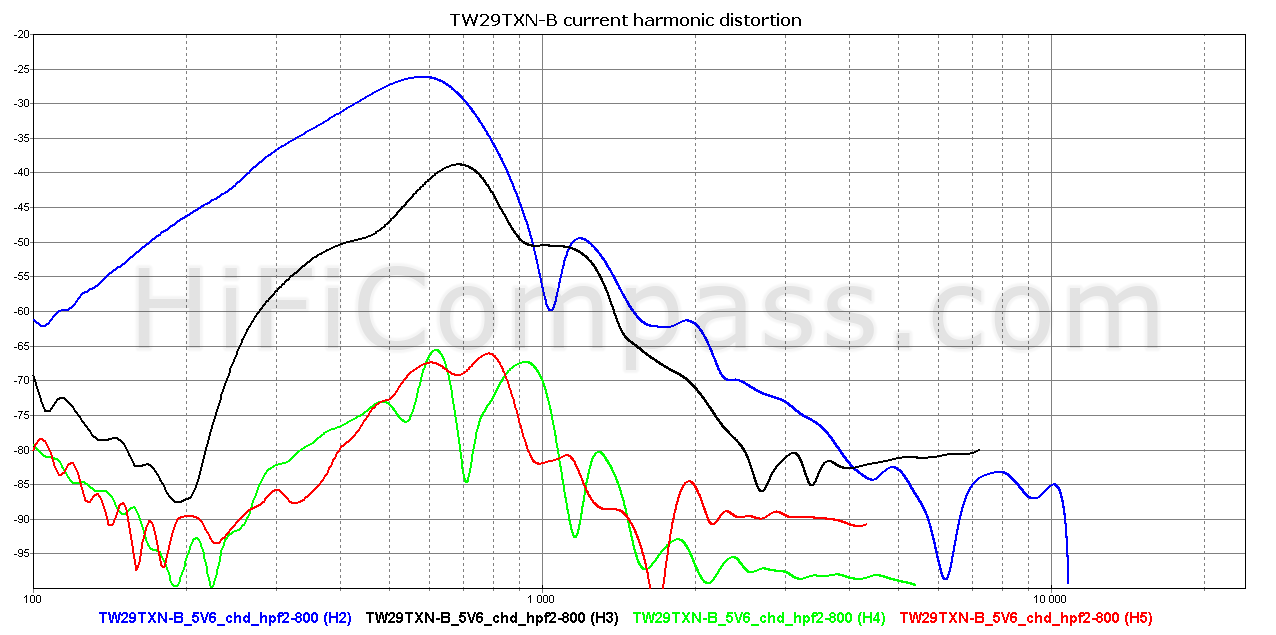 |
This type of measurement, despite its simplicity, is an excellent tool for assessing the linearity of a speaker motor. The above plots show the frequency dependences of the 2nd, 3rd, 4th and 5th harmonics of the voice coil current at 2 and 5.6 Volt. To limit the speaker overload in terms of thermal power and membrane displacement when measuring harmonic distortion, a second-order Butterworth type high-pass filter with a cutoff frequency of 800 Hz was used.
Voice coil current nonlinearity is the direct nonlinearity of the mechanical force driving the speaker cone, since this force is related to the current by a simple relationship F=B*L*I, where B is the magnetic field strength, L is the length of the voice coil wire inside the magnetic gap and I is the current. So, in principle, it is practically impossible to obtain sound pressure distortion lower than current distortion in the frequency range where the contribution of the motional nonlinearity becomes insignificant.
The voice coil current harmonics behavior is very similar to the SPL harmonic distortion, with only exception that the 2nd harmonic of the current is much less than for the SPL. One of the reasons may be non symmetrical radiation of the tweeter surround. The effective radiation area of the TW29TXN-B very wide surround is no less than 50% of its membrane area, so it contributes significantly to the overall linearity of the tweeter.
Intermodulation distortion
The intermodulation distortion measurement is one of way of analyzing device non-linearity. It is not an alternative, but an additional method and allows you to identify the spectral components of the inharmonious structure, which are much more harmful for high-quality sound reproduction and to which our hearing is more sensitive.
- test frequencies
- 2nd order harmonic distortion components for the test frequencies (2nd HD)
- 3rd order harmonic distortion components for the test frequencies (3rd HD)
- 2nd order intermodulation distortion amplitude (IMA2)
- 3rd order intermodulation distortion amplitude (IMA3)
 |
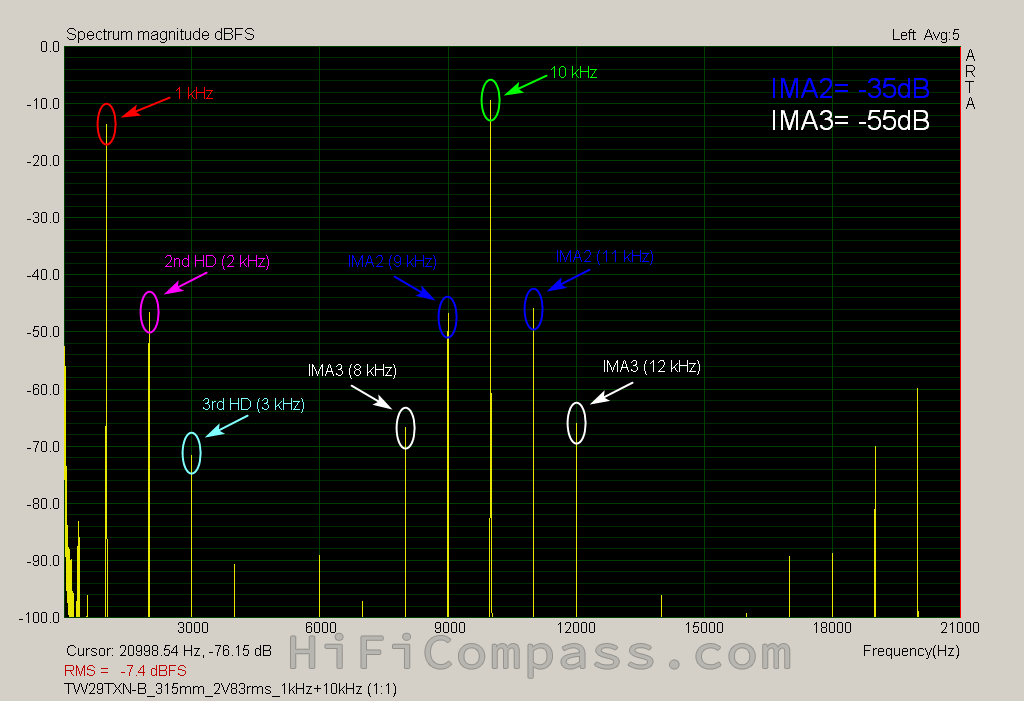 |
As you can see, just a couple of frequencies at the speaker terminals give rise to a whole forest of parasitic components at its output. The second order IMD component is -59 dB for the 19+20kHz pair. This is a very good figure.
When overloaded with a 1 kHz sine voltage of 2.83 Volts the IMA2 is only -35 dB for the frequency of 10 kHz, so you should be very careful when choosing a low cutoff frequency and a filter slope for the tweeter.
Step response
The step response demonstrates excellent slew rate and fast return to the zero line. It only once makes a small deviation in the negative direction beyond the zero line, after which it asymptotically goes to the rest state. This is a typical step response of "right" tweeters.
Waterfall
The waterfall shows the same effects as a step response, in addition exposing hidden resonances that are difficult to see in other types of measurements.
If you don't find fault, then we have an excellent, fast decaying waterfall. After the second slice everything is clean and the traces of membrane breakups above 30 kHz are very weak and also quickly disappear.
Listening impressions. Satori TW29TXN vs Satori TW29BN vs Satori TW29DN
As such a reference point I decided to choose the well-known TW29TXN-B siblings - beryllium dome Satori TW29BN-B silk dome Satori TW29DN-B. They have been on the market for several years and many already have managed to listen to them, so it will be easier for them to understand me.
At first, let's make an objective comparison of their main characteristics. All the tweeters are identical except for the membrane material.
 |
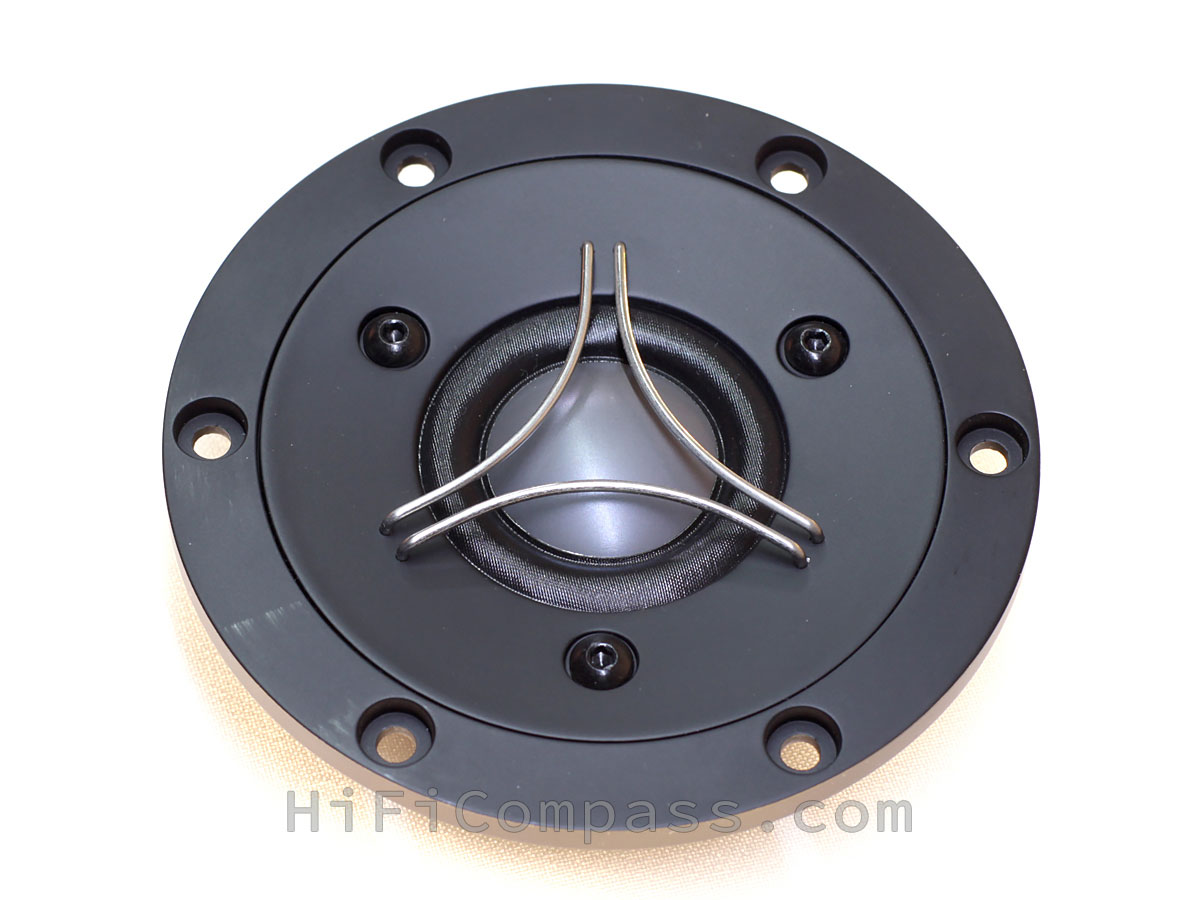 |
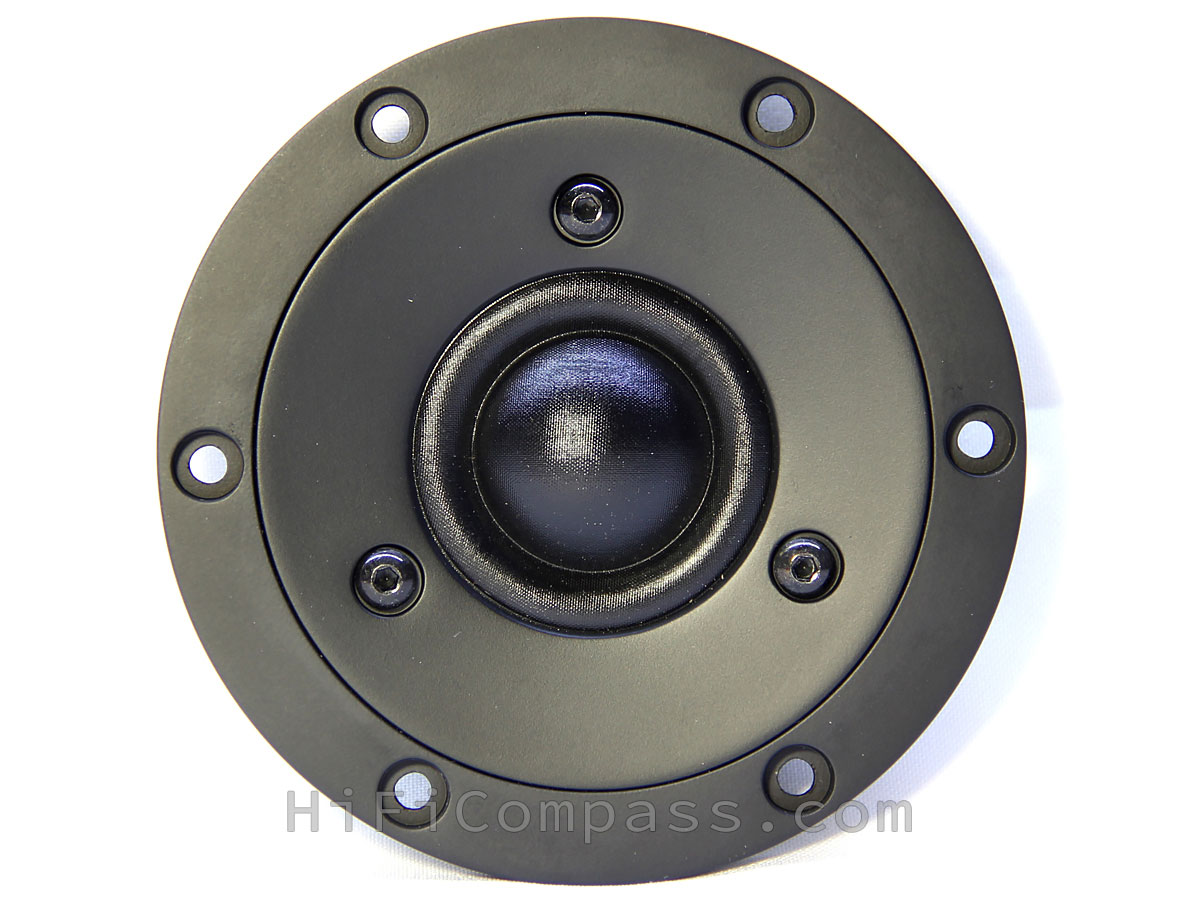 |
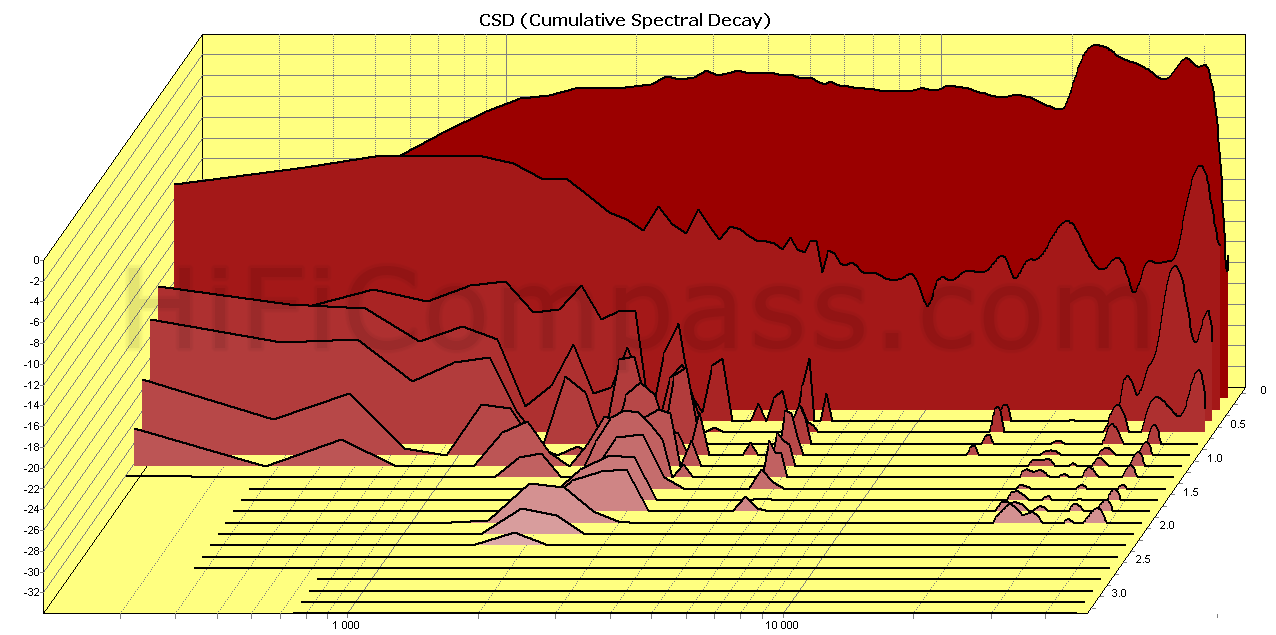 |
 |
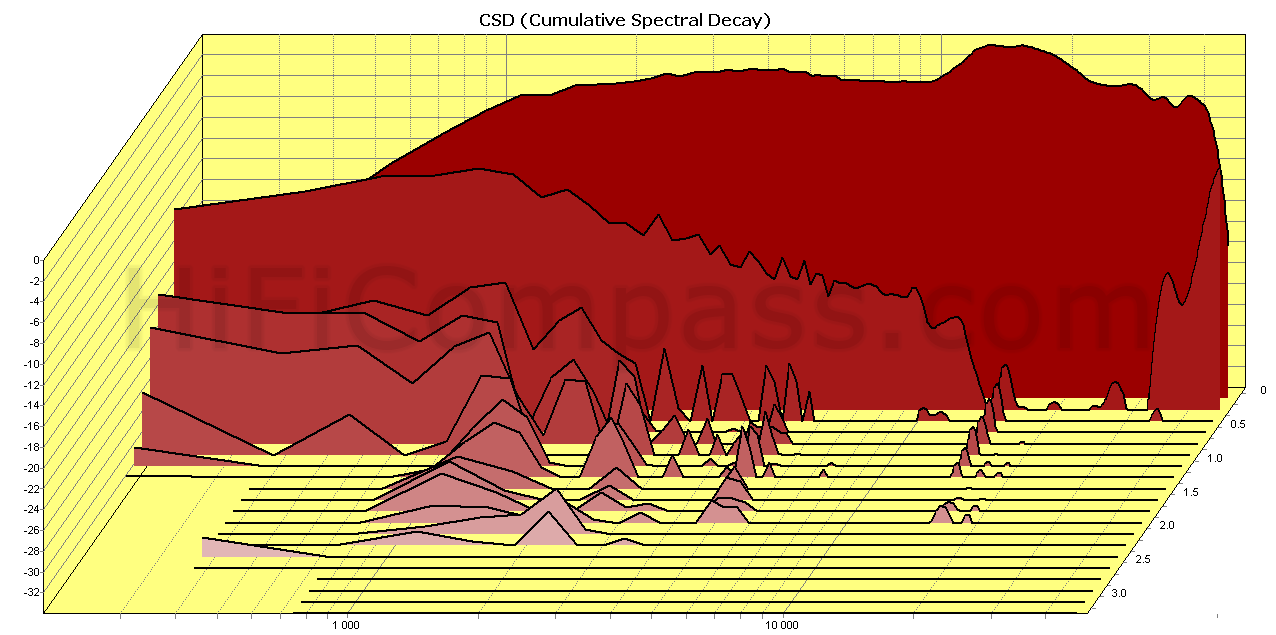 |
 |
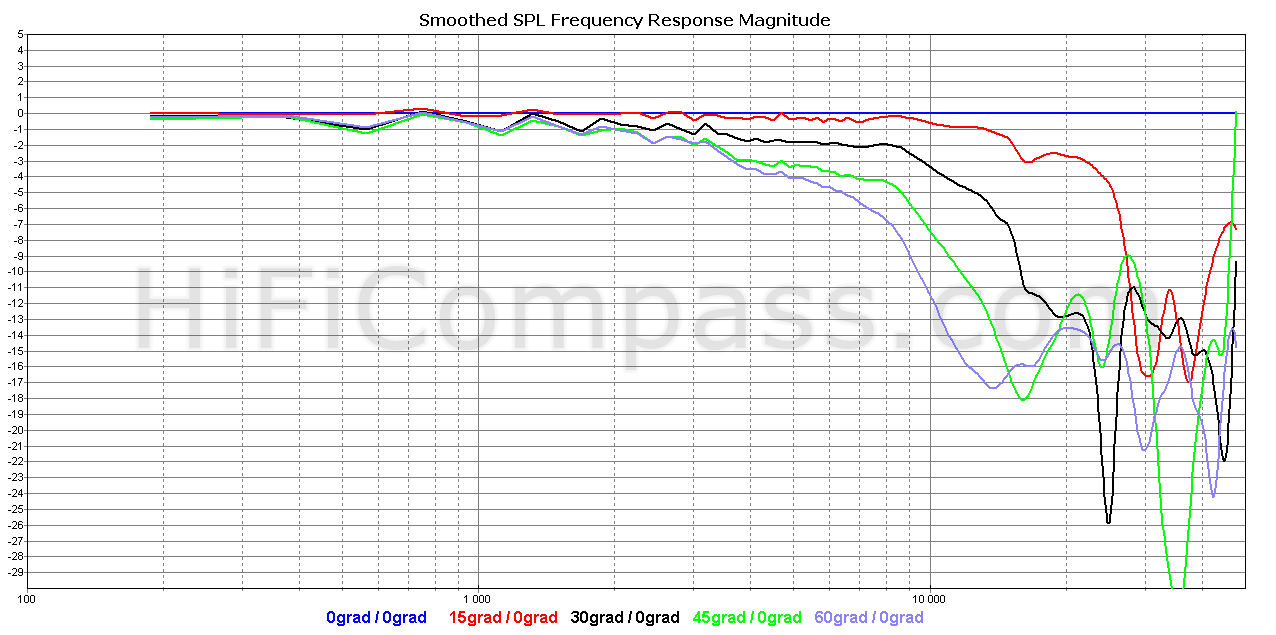 |
 |
The frequency responses of all the tweeters are identical up to 10 kHz. The silk dome's response starts to be very different from the other two above 10 kHz. Beryllium and TeXtreme are very close to each other here.
The waterfall looks best for the silk dome. TeXtreme breathes in his back and beryllium closes the triple due to the longer tails of the membrane break-up resonances.
Off-axis responses are best for the TeXtreme tweeter, followed by beryllium and silk, which has the least radiated energy in the top octave.
In terms of harmonic distortion TeXtreme turned out to be the best with a slight margin.
From an objective measurements point of view TW29TXN-B is a small step above the rest.
I decided to make the subjective comparison "by ear" in the most realistic and identical conditions, namely, to compare the tweeters, that is built into real loudspeakers. To do this, I replaced the TW29R with the TW29TXN-B and TW29BN-B inmy two-way loudspeakers based on the Satori MW16P-4/Satori TW29R. I listened to them one by one, switching the speakers on the fly using the A/B relay. The comparison lasted unhurriedly over several days in order to exclude the influence of a possible "wow-effect" and using a wide variety of musical material.
The silk dome TW29DN-B was not included in the comparison, because it is too different in sound. It was much interesting for me to compare the tweeters with rigid membranes.
Both tweeters immediately show their "rigid" character, drawing a very clean and transparent musical picture. Percussion instruments are reproduced very precisely and well outlined in the space, they have lifelike dynamic and attack.
The beryllium tweeter sounds noticeably brighter and festive. The cymbals sound more realistic and pianos more energetic. I would give it my preference for musical genres such as rock, heavy metal, blues, big bands, pop, techno, symphonic orchestras with an abundance of percussion. It sounds more dynamic and lifelike.
TeXtreme sounds kind of slightly muted, more calm and neutral. Its strong point is a very delicate hadling of vocals and low-level micro-textures of winds and strings instruments. Here it surprises with its ability to reproduce the smallest details and musical touches. If such instruments and the human voices are what you like the most, TW29TXN-B will thank you in full. With its ability to render very delicate the finest nuances and show up the sound micro-texture, it strongly reminded me of the sound signature of diamond tweeters. Is it because their membranes are based on carbon?
Both tweeters, thanks to a narrower sound dispersion compared to 1" tweeters, sound slightly forward, closer to the listener, subjectively emphasizing the 3-10 kHz range, as if pulling details from the depth of the soundstage. On some music this creates the effect of the presence of performers next to you and increases the feeling involvement, on others this may disrupt the natural sound perspective. This notice relates not only to the Satori tweeters, but to all the tweeters with narrow sound dispersion.
"How to use" recomendations
TW29TXN-B can be used in two or three-way loudspeakers of the highest level. Its lower frequency limit depends on the maximum volume you are going to get from it. If your room is no more than 20-25 sq.m. and you listen to music not very loudly, this tweeter can easily handle even 1.5 kHz. It all depends on your individual nonlinear distortion sensitivity. The same applies to the slope of its filtering.
What is the price and where to purchase it?
The TW29TXN-B are already on the market. The retail price is €190-233 per piece excluding VAT. It can be purchased in the following online stores:
- https://www.madisoundspeakerstore.com/soft-dome-tweeters-satori/satori-t...
- https://www.audiohobby.eu/ru/dinamiki/15127-sb-acoustics-satori-tw29txn-...
Summary
The TW29TXN-B is a worthy addition to the Satori line. The designers did a good job on the construction, paying attention to each element. The result is a superb modern tweeter with a nice design, great performance and sound. I don't see any weak points in it at all. Compare with the silk dome version the new more rigid TeXtreme membrane has added transparency and detail to the sound, but did it very delicately, without introducing into the sound of coldness, emptiness, ringing and sterility, as is often the case with metal or ceramic materials. An excellent debut for the TPCD membrane. Personally, I very like the sound of the TW29TXN-B.
Based on the measurements and listening results, I consider the TW29TXN-B one of the best available tweeters today regardless of price.
Summarizing the above, I can highlight the following:
- high sensitivity - averaged 95 dB/2.83 V*1 m
- very extended and even frequency response
- very low harmonic distortion
- absolute dominance of the 2nd harmonic distortion in the entire range
- can be used down to 1.5 kHz
- low intermodulation distortion
- on-axis response slightly differs from datasheet
- off-axis responses doesn't correspond to the reality
- sound dispersion is worse compared to 1" tweeters
- good consistency of parameters and characteristics
- excellent production quality
You can get more information about the measurement results here
Yevgeniy Kozhushko/26.01.2021
CONTACTS
- Ukraine
- (+380) 95 904 7827
- hificompass@gmail.com
LAST NEWS
-
27 Mar 2025
-
04 Mar 2025
-
25 Feb 2025
-
10 Feb 2025
